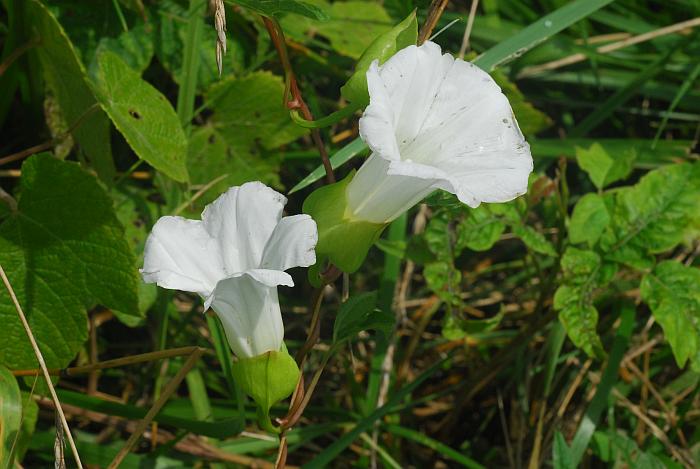Calystegia silvatica (Kit.) Griseb.
Hedge Bindweed

Native
CC = 1
CW = 5
MOC = 45
© SRTurner
Calystegia silvatica (Kit.) Griseb.Hedge Bindweed | |
 |
Native CC = 1 CW = 5 MOC = 45 |
© SRTurner |
|
Family - Convolvulaceae Habit - Rhizomatous perennial forb, twining on other vegetation. Stem - Twining and climbing on other vegetation, to 3 m, glabrous.
Leaves - Alternate, long petiolate, glabrous. Petioles longer than half the length of the blade midveins. Blades to 8 cm, narrowly ovate-triangular, usually sharply pointed at tip, deeply cordate at base, the basal sinus quadrate (opposing sides parallel) but often with small, angular bands of tissue tapering along the apical portion of the petiole, the 2 basal lobes often each with 1 or 2 additional shallow lobes along the upper portion, frequently usually spreading, angular, bluntly to sharply pointed. Blades otherwise entire.
Inflorescences - Flowers usually paired in the axils of leaves, less commonly solitary. Bracts 16-28 mm long, usually strongly overlapping, often strongly inflated, ovate, rounded to bluntly pointed at the tip, glabrous or sparsely hairy along the margins.
Flower - Actinomorphic, hypogynous, perfect. Sepals 11-15 mm long, free, elliptic to narrowly ovate. Corollas very shallowly 5-lobed, 4-7 cm long, funnelform, white, rarely pink tinged. Stamens 5, alternating with corolla lobes, not exserted. Pistil 1 per flower, of 2 fused carpels. Ovary superior, 2-locular, usually appearing 1-locular toward the tip, with 4 ovules. Style 1, the stigmas 2, oblong to ovate in outline, somewhat flattened.
Fruits - Capsules, globose to ovoid, 10-15 mm long, 1-locular, dehiscing longitudinally, the wall separating into 4 segments. Seeds 1-4, 4-6 mm long, oblong-ovate to ovate in outline, somewhat longitudinally angled on the inner face, the surface smooth to very finely granular, dark brown to more commonly black, glabrous. Flowering - May - September. Habitat - Hedgerows, forest borders, streambanks, pond margins, fields, pastures. Origin - Native to the U.S. Lookalikes - Calystegia sepium; more broadly, several other members of the Calystegia and Convolvulus genera. Other info. - This species is common across most of Missouri. Its U.S. range extends eastward to the eastern seaboard. It would appear to be far less common than its close sibling C. sepium, though some part of this difference may be due to differences in its recognition as a discrete species. Characters which point to this species include a leaf basal sinus (recess surrounding the petiole attachment) which is quadrate, having parallel sides at an abrupt right angle relative to the base. The bracts subtending the flower are blunt, ovate, strongly overlapping, and often appear inflated. Differentiation of this species from C. sepium is somewhat controversial - see that entry for more information. Some specimens do not key well, exhibiting contradictory characters. Photographs taken at Holly Ridge Conservation Area, Stoddard County, MO, 8-15-2009, Broemmelsiek County Park, St. Charles County, MO, 6-24-2010, and Shaw Nature Reserve, Franklin County, MO, 7-17-2015 (SRTurner). |